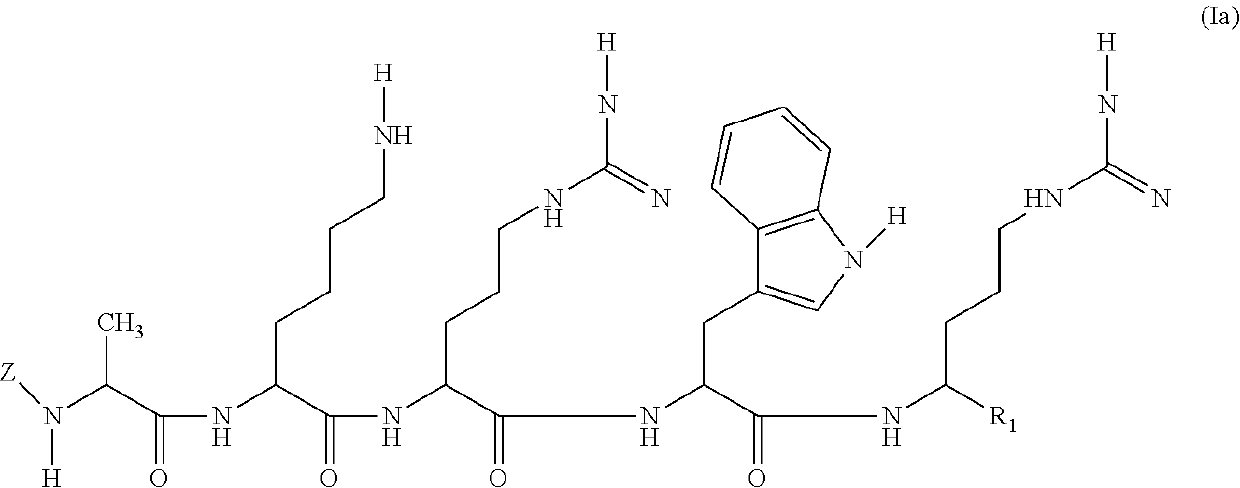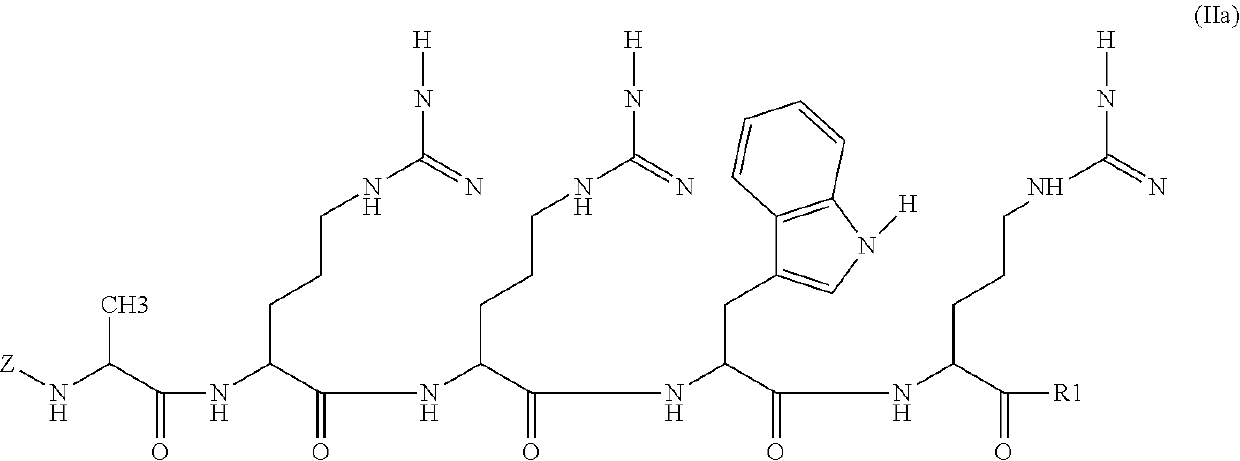Peptidic protein kinase c inhibitors and uses thereof
a protein kinase and inhibitor technology, applied in the field of new, can solve the problems of narrow therapeutic window, unspecific mode of action of tj modulating agents used as absorption enhancers, and ineffective anti-tumor drugs, and achieve the effect of improving the progression free survival
- Summary
- Abstract
- Description
- Claims
- Application Information
AI Technical Summary
Benefits of technology
Problems solved by technology
Method used
Image
Examples
example 1
of Compounds According to the Invention
[0151]Compounds of the invention are prepared by solid phase peptide synthesis. As an illustration, the steps of the synthesis of Peptide P4 (SEQ ID NO: 2) are provided below:
[0152]Step 1—The reaction vessel was washed with dichloromethane (DCM) and bottom blown with nitrogen and then drained completely.
[0153]Step 2—Resin swelling: 2-Chlorotrityl Chloride Resin was weighed in the reaction vessel, the resin was then swollen with dimethylformamide (DMF; 15 ml / g) for 30 min.
[0154]Step 3—Coupling of the first D-amino acid from the C-terminus of the peptide: 1.6 g of Fmoc-L-Arg(Pbf)-OH were weighted in a test tube and Fmoc (9-Fluorenylmethyloxycarbonyl)-amino acids were dissolved in DMF / DCM (Sigma-Aldrich) (1:1) (15 ml / g). The solution was transferred into the reaction vessel described above, 10 times DIEA (N,N-Diisopropylethylamine) was added and mixed for 30 min at room temperature with nitrogen.
[0155]Step 4—Blocking the active site of the resin: ...
example 2
f Peptides of Various Lengths Increase on Membrane Permeability of Macromolecules
[0178]To assess the potential effects of peptides of the invention on the permeabilization of therapeutic molecules, FITC Insulin (Sigma-Aldrich, Buchs SG, Switzerland) is used as a model for assessing paracellular drug transport (apical to basolateral) across the epithelial monolayer.
[0179]To ensure that the integrity of the monolayer is maintained during the course of the experiment, trans-epithelial electrical resistance (TEER) is measured before and after these studies, as described below.
[0180]Mucilair™ human primary nasal and bronchial epithelial cells (Epithelix sarl, Geneva, Switzerland) and Caco-2 human intestinal epithelial cells are used (Huang et. al., 2013, Toxicol. in Vitro 27: 1151-1156).
[0181]Before each experiment, the culture medium is removed from each compartment and the monolayer is washed once with 200 μl of saline (0.9%) and once with warm Hanks' Balanced Salt Solution (HBSS) (37°...
example 3
he Membrane Penetrating Group
[0185]To assess the role of the membrane penetrating group (myristoyl) in peptides of the invention in the enhancing of the permeability of macromolecules through epithelial cell layers, the permeabilizing capacity of peptide P4 (SEQ ID NO: 2) of the invention is compared to a comparative peptide corresponding to the same peptide without the myristoyl group. Uptake experiments and TEER is conducted as described in Example 2.
PUM
| Property | Measurement | Unit |
|---|---|---|
| surface area | aaaaa | aaaaa |
| non-polar | aaaaa | aaaaa |
| fatty acid | aaaaa | aaaaa |
Abstract
Description
Claims
Application Information
 Login to View More
Login to View More - R&D
- Intellectual Property
- Life Sciences
- Materials
- Tech Scout
- Unparalleled Data Quality
- Higher Quality Content
- 60% Fewer Hallucinations
Browse by: Latest US Patents, China's latest patents, Technical Efficacy Thesaurus, Application Domain, Technology Topic, Popular Technical Reports.
© 2025 PatSnap. All rights reserved.Legal|Privacy policy|Modern Slavery Act Transparency Statement|Sitemap|About US| Contact US: help@patsnap.com



